Report: Stress Amongst Undergraduate University Students in the UK
VerifiedAdded on 2022/08/18
|41
|9401
|12
Report
AI Summary
This report delves into the critical issue of stress among undergraduate university students in the UK, examining its various facets and impacts. The study investigates academic, social, and emotional stressors, analyzing their influence on student well-being and performance. The research employs a mixed methodology, including both qualitative and quantitative data collection, to explore the factors contributing to stress, the awareness students have of these stressors, and the coping mechanisms they employ. The findings highlight the significant effects of stress, particularly on mental health, and identify key areas for intervention. The report includes a comprehensive literature review, detailed methodology, results, and discussion, offering valuable insights for universities and students. This study aims to provide a comprehensive understanding of student stress, offering practical strategies for managing and mitigating its negative consequences, ultimately supporting a healthier and more successful university experience. The report includes a questionnaire, data analysis, and discussion of the results, offering valuable insights into the issue.
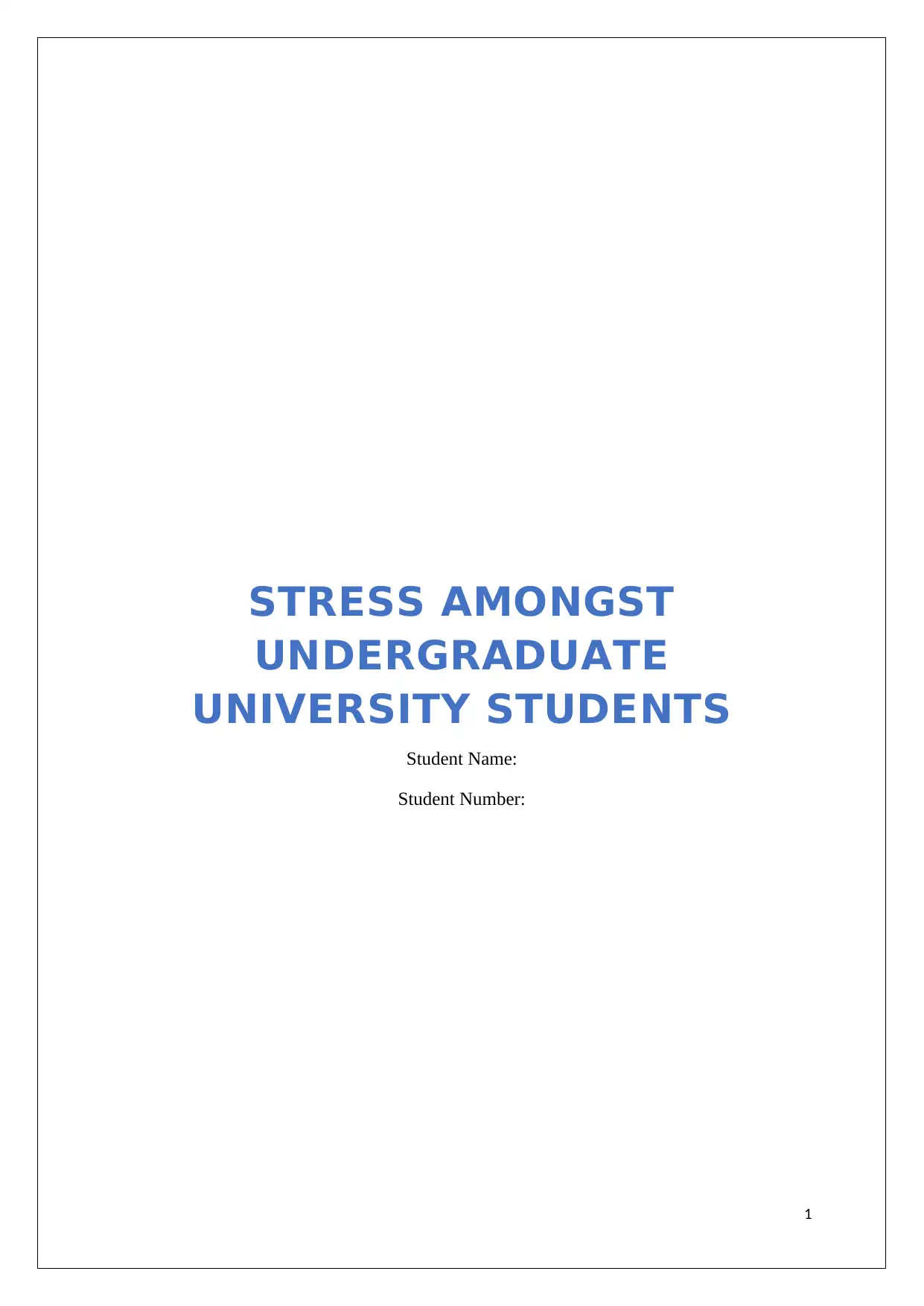
STRESS AMONGST
UNDERGRADUATE
UNIVERSITY STUDENTS
Student Name:
Student Number:
1
UNDERGRADUATE
UNIVERSITY STUDENTS
Student Name:
Student Number:
1
Paraphrase This Document
Need a fresh take? Get an instant paraphrase of this document with our AI Paraphraser
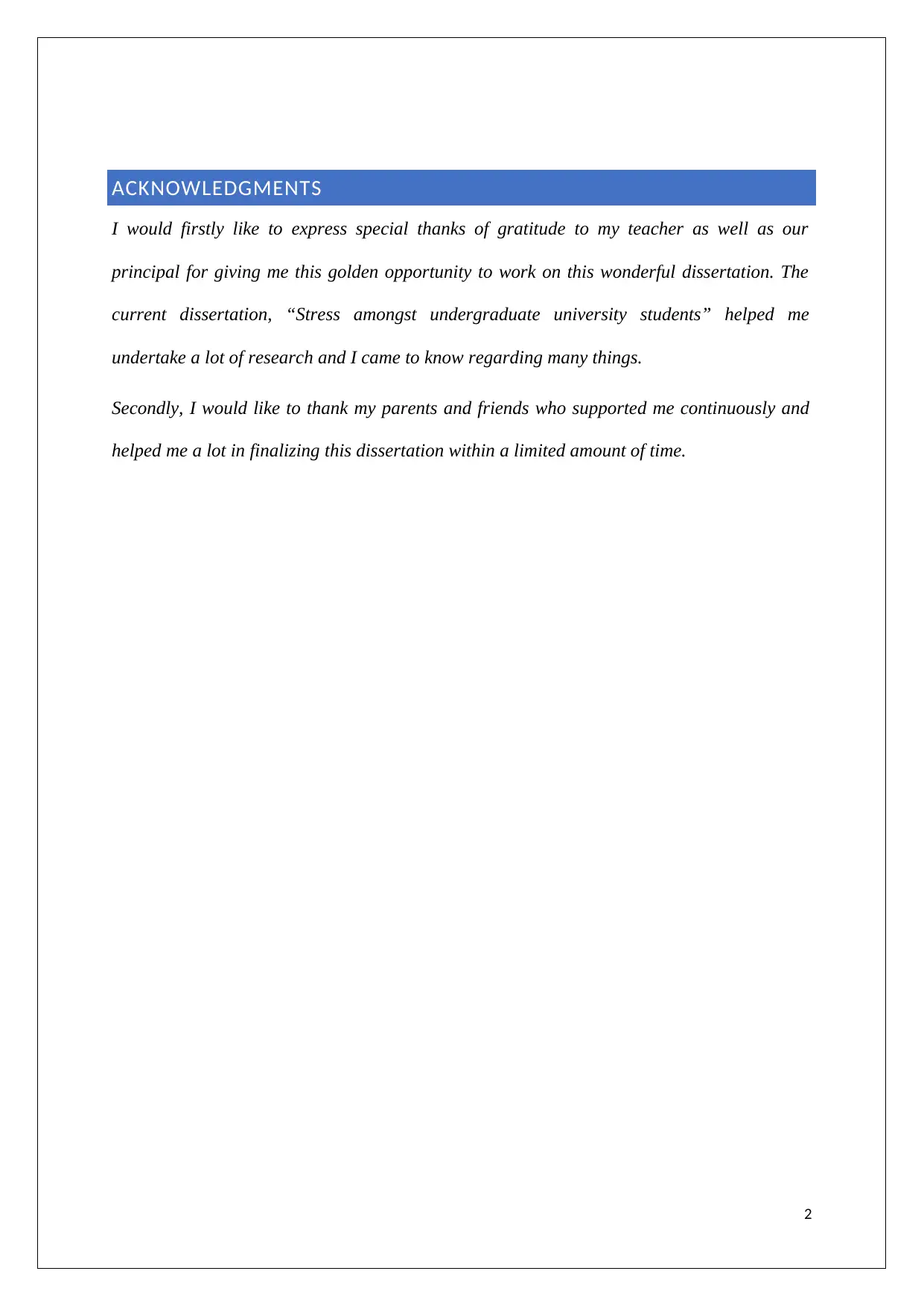
ACKNOWLEDGMENTS
I would firstly like to express special thanks of gratitude to my teacher as well as our
principal for giving me this golden opportunity to work on this wonderful dissertation. The
current dissertation, “Stress amongst undergraduate university students” helped me
undertake a lot of research and I came to know regarding many things.
Secondly, I would like to thank my parents and friends who supported me continuously and
helped me a lot in finalizing this dissertation within a limited amount of time.
2
I would firstly like to express special thanks of gratitude to my teacher as well as our
principal for giving me this golden opportunity to work on this wonderful dissertation. The
current dissertation, “Stress amongst undergraduate university students” helped me
undertake a lot of research and I came to know regarding many things.
Secondly, I would like to thank my parents and friends who supported me continuously and
helped me a lot in finalizing this dissertation within a limited amount of time.
2
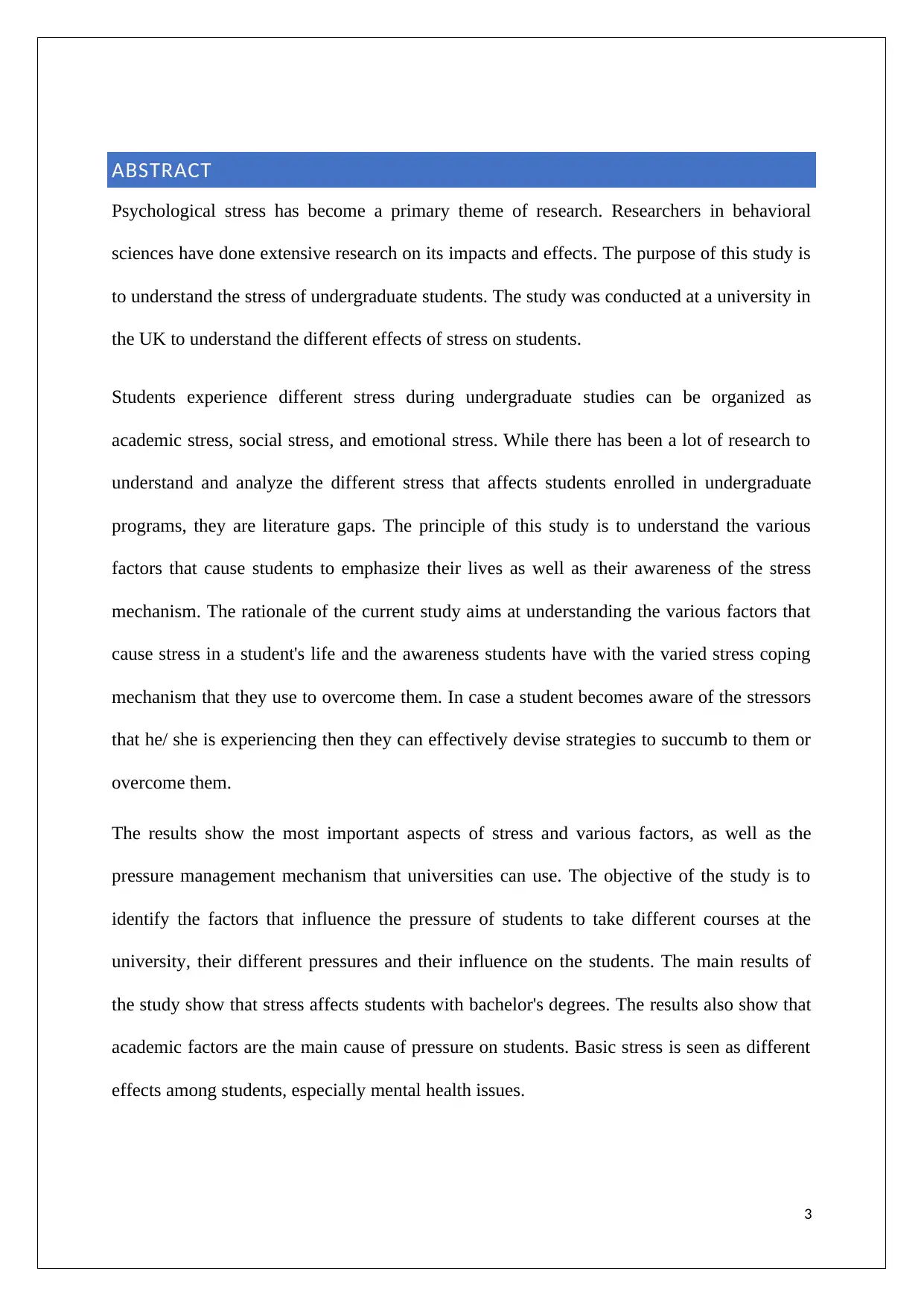
ABSTRACT
Psychological stress has become a primary theme of research. Researchers in behavioral
sciences have done extensive research on its impacts and effects. The purpose of this study is
to understand the stress of undergraduate students. The study was conducted at a university in
the UK to understand the different effects of stress on students.
Students experience different stress during undergraduate studies can be organized as
academic stress, social stress, and emotional stress. While there has been a lot of research to
understand and analyze the different stress that affects students enrolled in undergraduate
programs, they are literature gaps. The principle of this study is to understand the various
factors that cause students to emphasize their lives as well as their awareness of the stress
mechanism. The rationale of the current study aims at understanding the various factors that
cause stress in a student's life and the awareness students have with the varied stress coping
mechanism that they use to overcome them. In case a student becomes aware of the stressors
that he/ she is experiencing then they can effectively devise strategies to succumb to them or
overcome them.
The results show the most important aspects of stress and various factors, as well as the
pressure management mechanism that universities can use. The objective of the study is to
identify the factors that influence the pressure of students to take different courses at the
university, their different pressures and their influence on the students. The main results of
the study show that stress affects students with bachelor's degrees. The results also show that
academic factors are the main cause of pressure on students. Basic stress is seen as different
effects among students, especially mental health issues.
3
Psychological stress has become a primary theme of research. Researchers in behavioral
sciences have done extensive research on its impacts and effects. The purpose of this study is
to understand the stress of undergraduate students. The study was conducted at a university in
the UK to understand the different effects of stress on students.
Students experience different stress during undergraduate studies can be organized as
academic stress, social stress, and emotional stress. While there has been a lot of research to
understand and analyze the different stress that affects students enrolled in undergraduate
programs, they are literature gaps. The principle of this study is to understand the various
factors that cause students to emphasize their lives as well as their awareness of the stress
mechanism. The rationale of the current study aims at understanding the various factors that
cause stress in a student's life and the awareness students have with the varied stress coping
mechanism that they use to overcome them. In case a student becomes aware of the stressors
that he/ she is experiencing then they can effectively devise strategies to succumb to them or
overcome them.
The results show the most important aspects of stress and various factors, as well as the
pressure management mechanism that universities can use. The objective of the study is to
identify the factors that influence the pressure of students to take different courses at the
university, their different pressures and their influence on the students. The main results of
the study show that stress affects students with bachelor's degrees. The results also show that
academic factors are the main cause of pressure on students. Basic stress is seen as different
effects among students, especially mental health issues.
3
⊘ This is a preview!⊘
Do you want full access?
Subscribe today to unlock all pages.

Trusted by 1+ million students worldwide
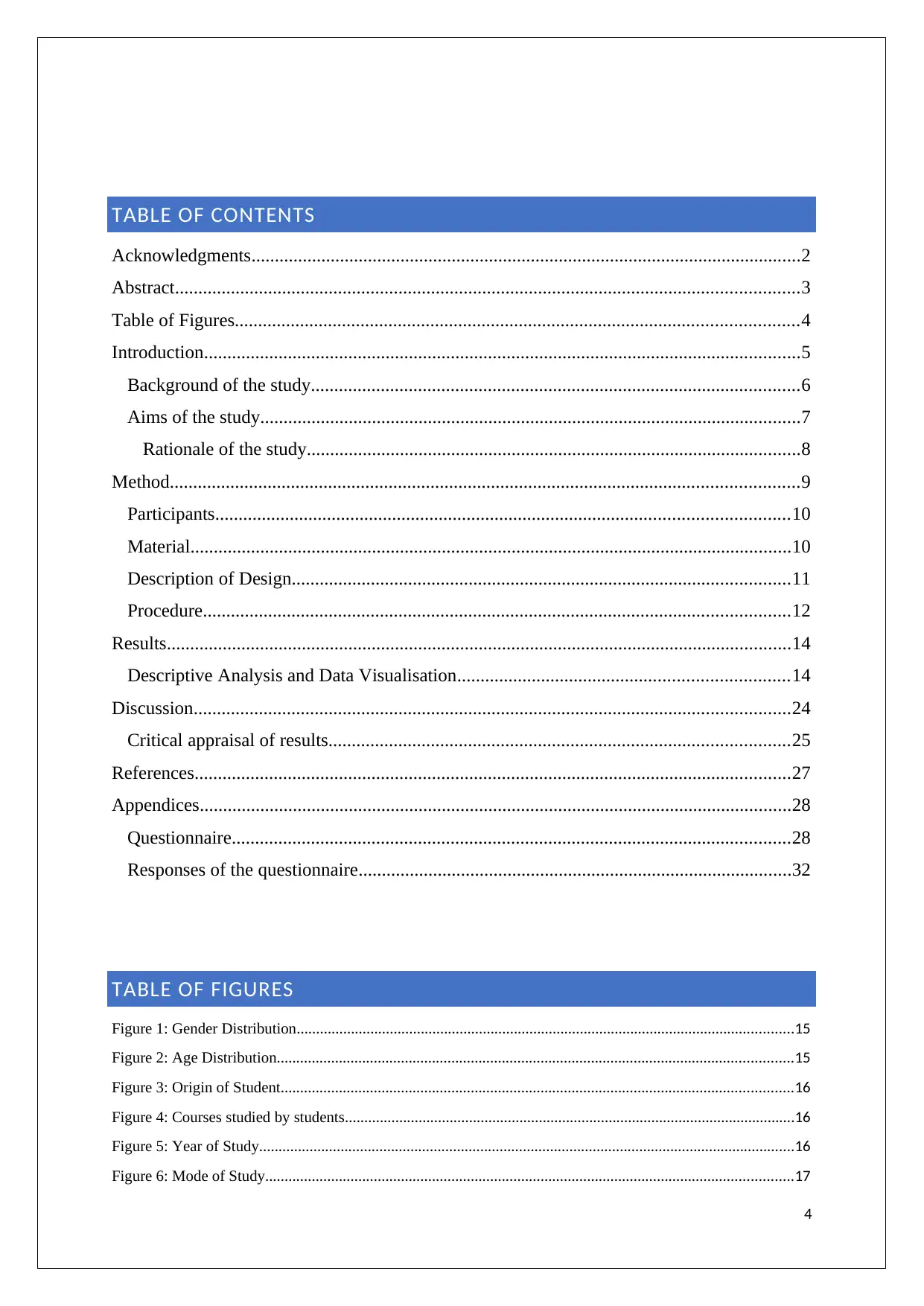
TABLE OF CONTENTS
Acknowledgments......................................................................................................................2
Abstract......................................................................................................................................3
Table of Figures.........................................................................................................................4
Introduction................................................................................................................................5
Background of the study.........................................................................................................6
Aims of the study....................................................................................................................7
Rationale of the study..........................................................................................................8
Method.......................................................................................................................................9
Participants...........................................................................................................................10
Material.................................................................................................................................10
Description of Design...........................................................................................................11
Procedure..............................................................................................................................12
Results......................................................................................................................................14
Descriptive Analysis and Data Visualisation.......................................................................14
Discussion................................................................................................................................24
Critical appraisal of results...................................................................................................25
References................................................................................................................................27
Appendices...............................................................................................................................28
Questionnaire........................................................................................................................28
Responses of the questionnaire.............................................................................................32
TABLE OF FIGURES
Figure 1: Gender Distribution................................................................................................................................15
Figure 2: Age Distribution.....................................................................................................................................15
Figure 3: Origin of Student....................................................................................................................................16
Figure 4: Courses studied by students....................................................................................................................16
Figure 5: Year of Study..........................................................................................................................................16
Figure 6: Mode of Study........................................................................................................................................17
4
Acknowledgments......................................................................................................................2
Abstract......................................................................................................................................3
Table of Figures.........................................................................................................................4
Introduction................................................................................................................................5
Background of the study.........................................................................................................6
Aims of the study....................................................................................................................7
Rationale of the study..........................................................................................................8
Method.......................................................................................................................................9
Participants...........................................................................................................................10
Material.................................................................................................................................10
Description of Design...........................................................................................................11
Procedure..............................................................................................................................12
Results......................................................................................................................................14
Descriptive Analysis and Data Visualisation.......................................................................14
Discussion................................................................................................................................24
Critical appraisal of results...................................................................................................25
References................................................................................................................................27
Appendices...............................................................................................................................28
Questionnaire........................................................................................................................28
Responses of the questionnaire.............................................................................................32
TABLE OF FIGURES
Figure 1: Gender Distribution................................................................................................................................15
Figure 2: Age Distribution.....................................................................................................................................15
Figure 3: Origin of Student....................................................................................................................................16
Figure 4: Courses studied by students....................................................................................................................16
Figure 5: Year of Study..........................................................................................................................................16
Figure 6: Mode of Study........................................................................................................................................17
4
Paraphrase This Document
Need a fresh take? Get an instant paraphrase of this document with our AI Paraphraser
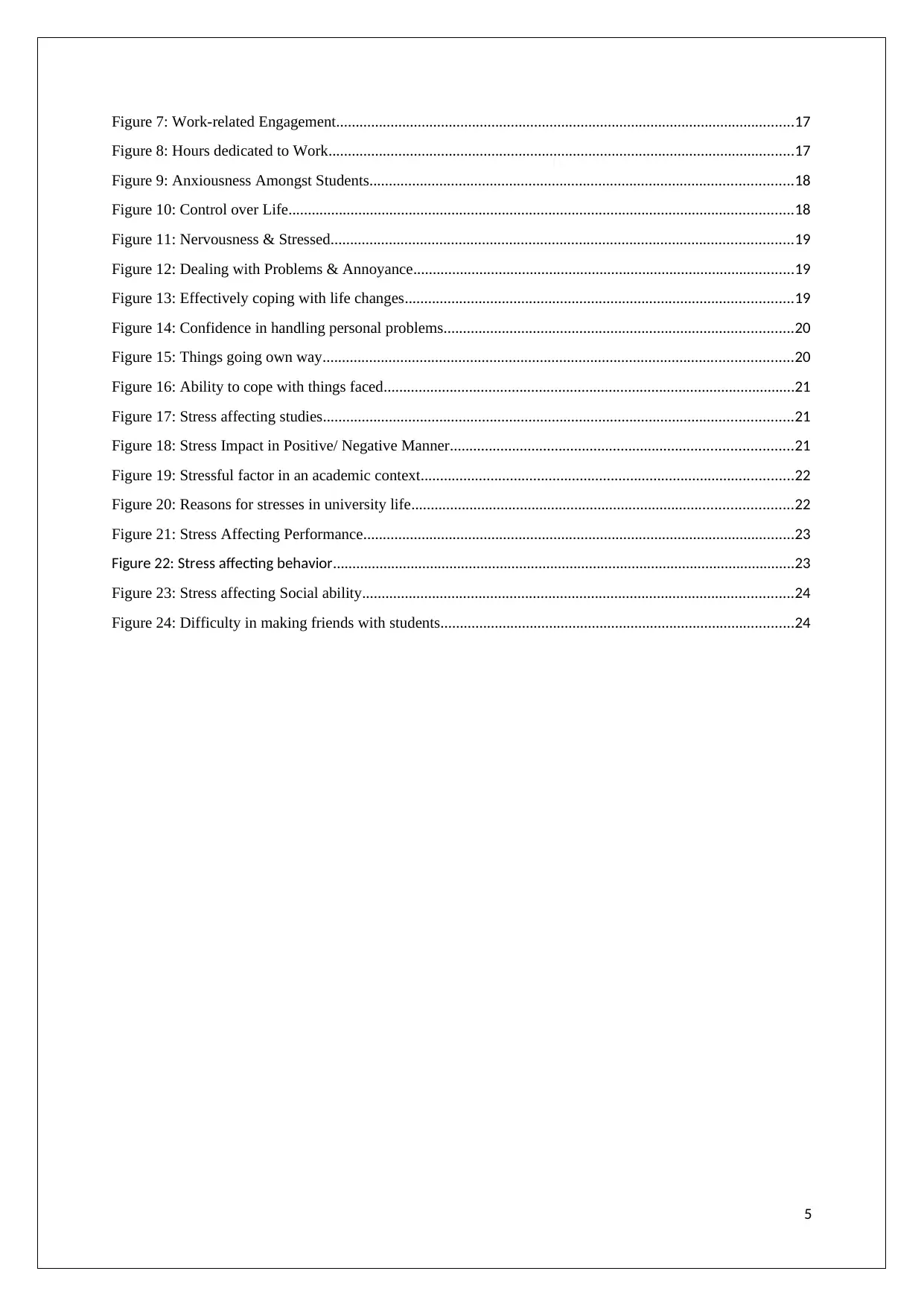
Figure 7: Work-related Engagement......................................................................................................................17
Figure 8: Hours dedicated to Work........................................................................................................................17
Figure 9: Anxiousness Amongst Students.............................................................................................................18
Figure 10: Control over Life..................................................................................................................................18
Figure 11: Nervousness & Stressed.......................................................................................................................19
Figure 12: Dealing with Problems & Annoyance..................................................................................................19
Figure 13: Effectively coping with life changes....................................................................................................19
Figure 14: Confidence in handling personal problems..........................................................................................20
Figure 15: Things going own way.........................................................................................................................20
Figure 16: Ability to cope with things faced..........................................................................................................21
Figure 17: Stress affecting studies.........................................................................................................................21
Figure 18: Stress Impact in Positive/ Negative Manner........................................................................................21
Figure 19: Stressful factor in an academic context................................................................................................22
Figure 20: Reasons for stresses in university life..................................................................................................22
Figure 21: Stress Affecting Performance...............................................................................................................23
Figure 22: Stress affecting behavior.......................................................................................................................23
Figure 23: Stress affecting Social ability...............................................................................................................24
Figure 24: Difficulty in making friends with students...........................................................................................24
5
Figure 8: Hours dedicated to Work........................................................................................................................17
Figure 9: Anxiousness Amongst Students.............................................................................................................18
Figure 10: Control over Life..................................................................................................................................18
Figure 11: Nervousness & Stressed.......................................................................................................................19
Figure 12: Dealing with Problems & Annoyance..................................................................................................19
Figure 13: Effectively coping with life changes....................................................................................................19
Figure 14: Confidence in handling personal problems..........................................................................................20
Figure 15: Things going own way.........................................................................................................................20
Figure 16: Ability to cope with things faced..........................................................................................................21
Figure 17: Stress affecting studies.........................................................................................................................21
Figure 18: Stress Impact in Positive/ Negative Manner........................................................................................21
Figure 19: Stressful factor in an academic context................................................................................................22
Figure 20: Reasons for stresses in university life..................................................................................................22
Figure 21: Stress Affecting Performance...............................................................................................................23
Figure 22: Stress affecting behavior.......................................................................................................................23
Figure 23: Stress affecting Social ability...............................................................................................................24
Figure 24: Difficulty in making friends with students...........................................................................................24
5
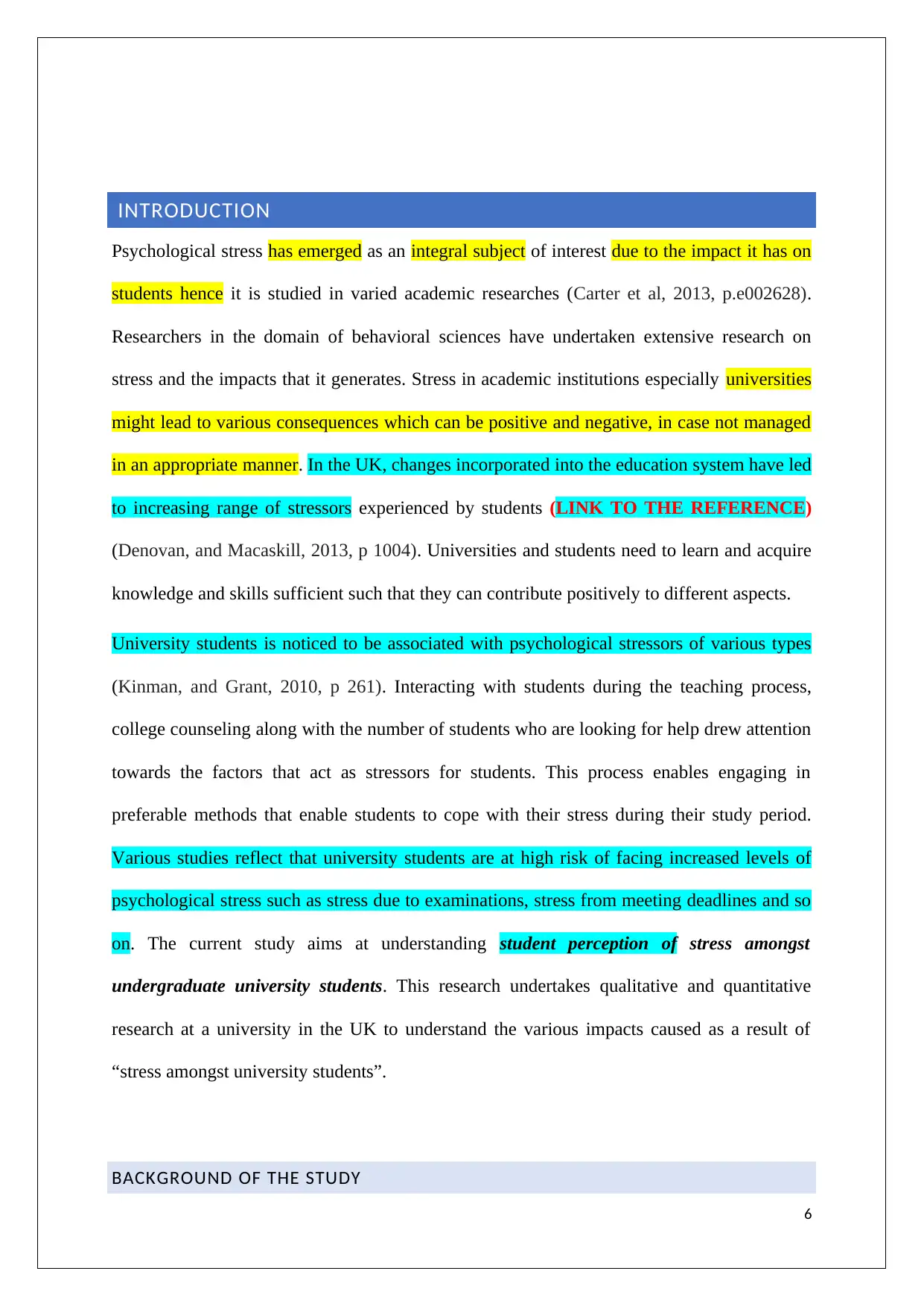
INTRODUCTION
Psychological stress has emerged as an integral subject of interest due to the impact it has on
students hence it is studied in varied academic researches (Carter et al, 2013, p.e002628).
Researchers in the domain of behavioral sciences have undertaken extensive research on
stress and the impacts that it generates. Stress in academic institutions especially universities
might lead to various consequences which can be positive and negative, in case not managed
in an appropriate manner. In the UK, changes incorporated into the education system have led
to increasing range of stressors experienced by students (LINK TO THE REFERENCE)
(Denovan, and Macaskill, 2013, p 1004). Universities and students need to learn and acquire
knowledge and skills sufficient such that they can contribute positively to different aspects.
University students is noticed to be associated with psychological stressors of various types
(Kinman, and Grant, 2010, p 261). Interacting with students during the teaching process,
college counseling along with the number of students who are looking for help drew attention
towards the factors that act as stressors for students. This process enables engaging in
preferable methods that enable students to cope with their stress during their study period.
Various studies reflect that university students are at high risk of facing increased levels of
psychological stress such as stress due to examinations, stress from meeting deadlines and so
on. The current study aims at understanding student perception of stress amongst
undergraduate university students. This research undertakes qualitative and quantitative
research at a university in the UK to understand the various impacts caused as a result of
“stress amongst university students”.
BACKGROUND OF THE STUDY
6
Psychological stress has emerged as an integral subject of interest due to the impact it has on
students hence it is studied in varied academic researches (Carter et al, 2013, p.e002628).
Researchers in the domain of behavioral sciences have undertaken extensive research on
stress and the impacts that it generates. Stress in academic institutions especially universities
might lead to various consequences which can be positive and negative, in case not managed
in an appropriate manner. In the UK, changes incorporated into the education system have led
to increasing range of stressors experienced by students (LINK TO THE REFERENCE)
(Denovan, and Macaskill, 2013, p 1004). Universities and students need to learn and acquire
knowledge and skills sufficient such that they can contribute positively to different aspects.
University students is noticed to be associated with psychological stressors of various types
(Kinman, and Grant, 2010, p 261). Interacting with students during the teaching process,
college counseling along with the number of students who are looking for help drew attention
towards the factors that act as stressors for students. This process enables engaging in
preferable methods that enable students to cope with their stress during their study period.
Various studies reflect that university students are at high risk of facing increased levels of
psychological stress such as stress due to examinations, stress from meeting deadlines and so
on. The current study aims at understanding student perception of stress amongst
undergraduate university students. This research undertakes qualitative and quantitative
research at a university in the UK to understand the various impacts caused as a result of
“stress amongst university students”.
BACKGROUND OF THE STUDY
6
⊘ This is a preview!⊘
Do you want full access?
Subscribe today to unlock all pages.

Trusted by 1+ million students worldwide
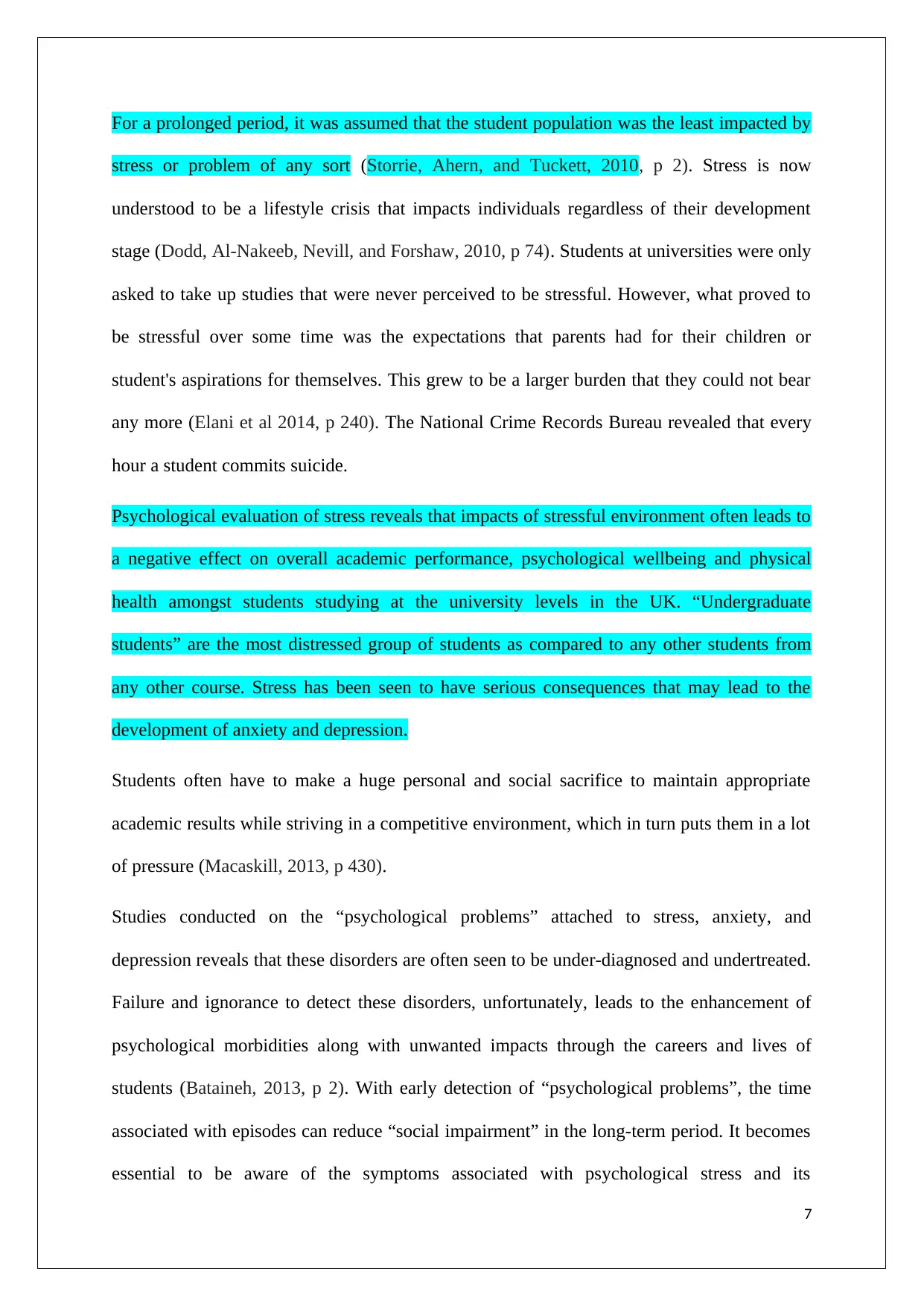
For a prolonged period, it was assumed that the student population was the least impacted by
stress or problem of any sort (Storrie, Ahern, and Tuckett, 2010, p 2). Stress is now
understood to be a lifestyle crisis that impacts individuals regardless of their development
stage (Dodd, Al-Nakeeb, Nevill, and Forshaw, 2010, p 74). Students at universities were only
asked to take up studies that were never perceived to be stressful. However, what proved to
be stressful over some time was the expectations that parents had for their children or
student's aspirations for themselves. This grew to be a larger burden that they could not bear
any more (Elani et al 2014, p 240). The National Crime Records Bureau revealed that every
hour a student commits suicide.
Psychological evaluation of stress reveals that impacts of stressful environment often leads to
a negative effect on overall academic performance, psychological wellbeing and physical
health amongst students studying at the university levels in the UK. “Undergraduate
students” are the most distressed group of students as compared to any other students from
any other course. Stress has been seen to have serious consequences that may lead to the
development of anxiety and depression.
Students often have to make a huge personal and social sacrifice to maintain appropriate
academic results while striving in a competitive environment, which in turn puts them in a lot
of pressure (Macaskill, 2013, p 430).
Studies conducted on the “psychological problems” attached to stress, anxiety, and
depression reveals that these disorders are often seen to be under-diagnosed and undertreated.
Failure and ignorance to detect these disorders, unfortunately, leads to the enhancement of
psychological morbidities along with unwanted impacts through the careers and lives of
students (Bataineh, 2013, p 2). With early detection of “psychological problems”, the time
associated with episodes can reduce “social impairment” in the long-term period. It becomes
essential to be aware of the symptoms associated with psychological stress and its
7
stress or problem of any sort (Storrie, Ahern, and Tuckett, 2010, p 2). Stress is now
understood to be a lifestyle crisis that impacts individuals regardless of their development
stage (Dodd, Al-Nakeeb, Nevill, and Forshaw, 2010, p 74). Students at universities were only
asked to take up studies that were never perceived to be stressful. However, what proved to
be stressful over some time was the expectations that parents had for their children or
student's aspirations for themselves. This grew to be a larger burden that they could not bear
any more (Elani et al 2014, p 240). The National Crime Records Bureau revealed that every
hour a student commits suicide.
Psychological evaluation of stress reveals that impacts of stressful environment often leads to
a negative effect on overall academic performance, psychological wellbeing and physical
health amongst students studying at the university levels in the UK. “Undergraduate
students” are the most distressed group of students as compared to any other students from
any other course. Stress has been seen to have serious consequences that may lead to the
development of anxiety and depression.
Students often have to make a huge personal and social sacrifice to maintain appropriate
academic results while striving in a competitive environment, which in turn puts them in a lot
of pressure (Macaskill, 2013, p 430).
Studies conducted on the “psychological problems” attached to stress, anxiety, and
depression reveals that these disorders are often seen to be under-diagnosed and undertreated.
Failure and ignorance to detect these disorders, unfortunately, leads to the enhancement of
psychological morbidities along with unwanted impacts through the careers and lives of
students (Bataineh, 2013, p 2). With early detection of “psychological problems”, the time
associated with episodes can reduce “social impairment” in the long-term period. It becomes
essential to be aware of the symptoms associated with psychological stress and its
7
Paraphrase This Document
Need a fresh take? Get an instant paraphrase of this document with our AI Paraphraser
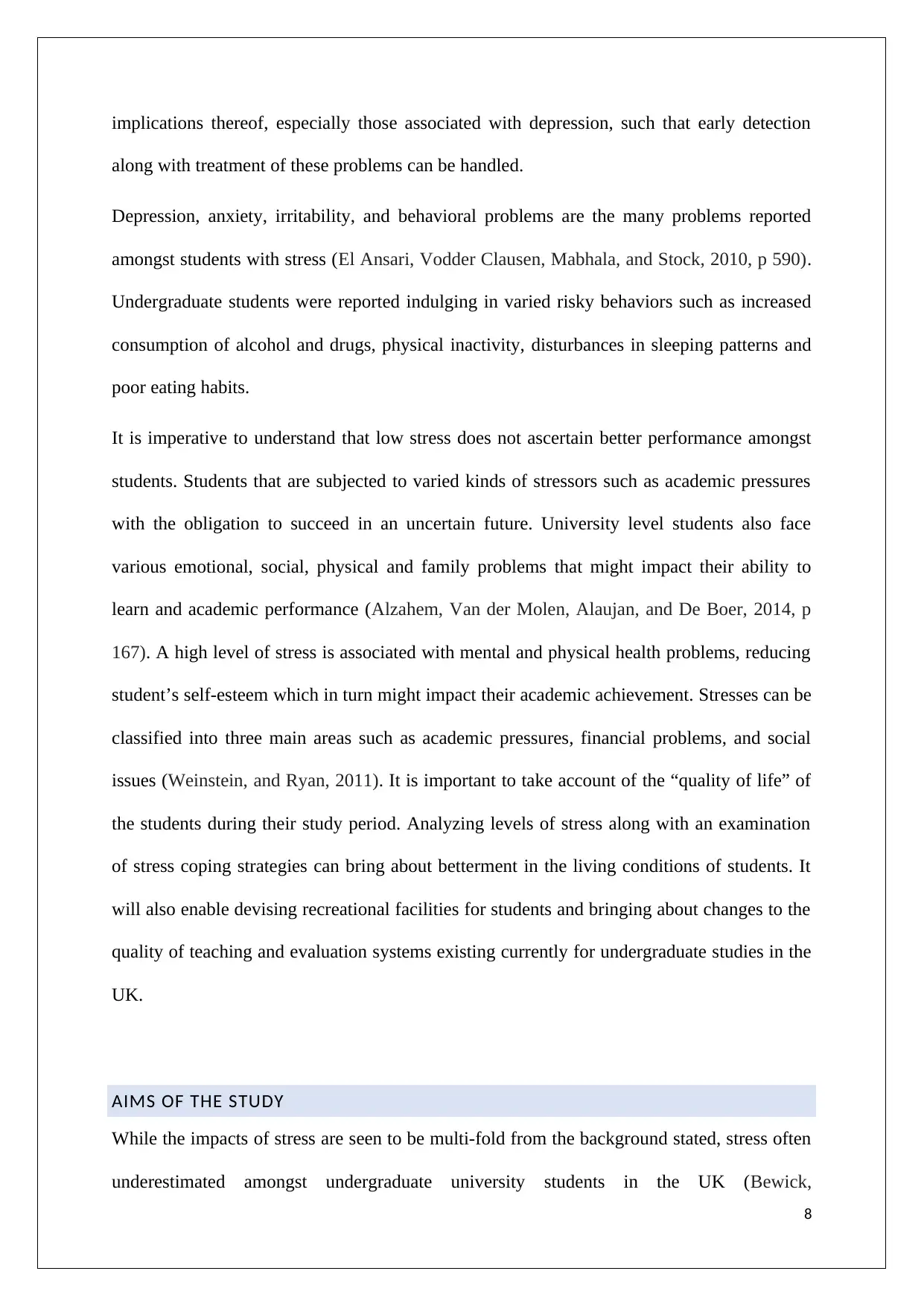
implications thereof, especially those associated with depression, such that early detection
along with treatment of these problems can be handled.
Depression, anxiety, irritability, and behavioral problems are the many problems reported
amongst students with stress (El Ansari, Vodder Clausen, Mabhala, and Stock, 2010, p 590).
Undergraduate students were reported indulging in varied risky behaviors such as increased
consumption of alcohol and drugs, physical inactivity, disturbances in sleeping patterns and
poor eating habits.
It is imperative to understand that low stress does not ascertain better performance amongst
students. Students that are subjected to varied kinds of stressors such as academic pressures
with the obligation to succeed in an uncertain future. University level students also face
various emotional, social, physical and family problems that might impact their ability to
learn and academic performance (Alzahem, Van der Molen, Alaujan, and De Boer, 2014, p
167). A high level of stress is associated with mental and physical health problems, reducing
student’s self-esteem which in turn might impact their academic achievement. Stresses can be
classified into three main areas such as academic pressures, financial problems, and social
issues (Weinstein, and Ryan, 2011). It is important to take account of the “quality of life” of
the students during their study period. Analyzing levels of stress along with an examination
of stress coping strategies can bring about betterment in the living conditions of students. It
will also enable devising recreational facilities for students and bringing about changes to the
quality of teaching and evaluation systems existing currently for undergraduate studies in the
UK.
AIMS OF THE STUDY
While the impacts of stress are seen to be multi-fold from the background stated, stress often
underestimated amongst undergraduate university students in the UK (Bewick,
8
along with treatment of these problems can be handled.
Depression, anxiety, irritability, and behavioral problems are the many problems reported
amongst students with stress (El Ansari, Vodder Clausen, Mabhala, and Stock, 2010, p 590).
Undergraduate students were reported indulging in varied risky behaviors such as increased
consumption of alcohol and drugs, physical inactivity, disturbances in sleeping patterns and
poor eating habits.
It is imperative to understand that low stress does not ascertain better performance amongst
students. Students that are subjected to varied kinds of stressors such as academic pressures
with the obligation to succeed in an uncertain future. University level students also face
various emotional, social, physical and family problems that might impact their ability to
learn and academic performance (Alzahem, Van der Molen, Alaujan, and De Boer, 2014, p
167). A high level of stress is associated with mental and physical health problems, reducing
student’s self-esteem which in turn might impact their academic achievement. Stresses can be
classified into three main areas such as academic pressures, financial problems, and social
issues (Weinstein, and Ryan, 2011). It is important to take account of the “quality of life” of
the students during their study period. Analyzing levels of stress along with an examination
of stress coping strategies can bring about betterment in the living conditions of students. It
will also enable devising recreational facilities for students and bringing about changes to the
quality of teaching and evaluation systems existing currently for undergraduate studies in the
UK.
AIMS OF THE STUDY
While the impacts of stress are seen to be multi-fold from the background stated, stress often
underestimated amongst undergraduate university students in the UK (Bewick,
8
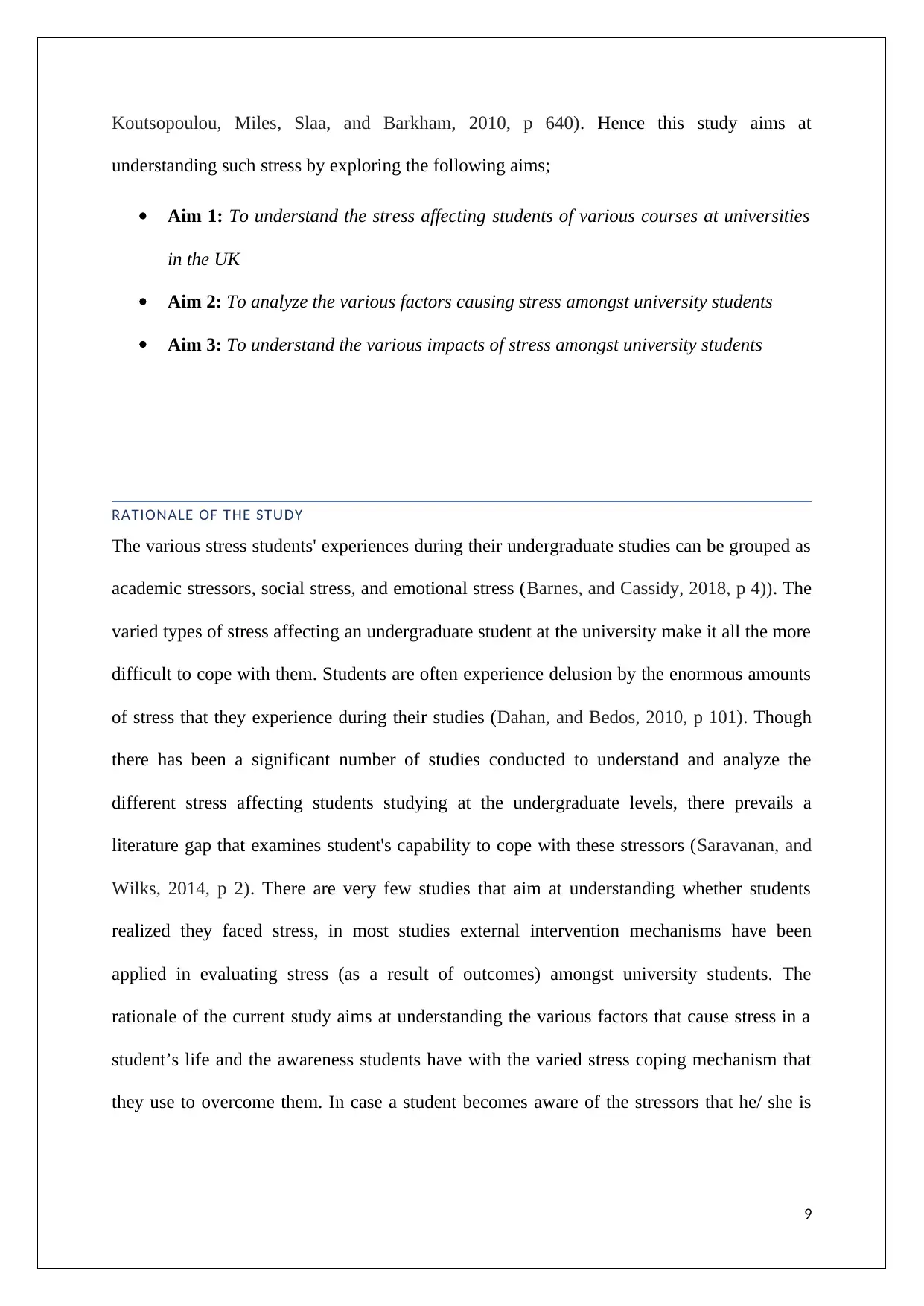
Koutsopoulou, Miles, Slaa, and Barkham, 2010, p 640). Hence this study aims at
understanding such stress by exploring the following aims;
Aim 1: To understand the stress affecting students of various courses at universities
in the UK
Aim 2: To analyze the various factors causing stress amongst university students
Aim 3: To understand the various impacts of stress amongst university students
RATIONALE OF THE STUDY
The various stress students' experiences during their undergraduate studies can be grouped as
academic stressors, social stress, and emotional stress (Barnes, and Cassidy, 2018, p 4)). The
varied types of stress affecting an undergraduate student at the university make it all the more
difficult to cope with them. Students are often experience delusion by the enormous amounts
of stress that they experience during their studies (Dahan, and Bedos, 2010, p 101). Though
there has been a significant number of studies conducted to understand and analyze the
different stress affecting students studying at the undergraduate levels, there prevails a
literature gap that examines student's capability to cope with these stressors (Saravanan, and
Wilks, 2014, p 2). There are very few studies that aim at understanding whether students
realized they faced stress, in most studies external intervention mechanisms have been
applied in evaluating stress (as a result of outcomes) amongst university students. The
rationale of the current study aims at understanding the various factors that cause stress in a
student’s life and the awareness students have with the varied stress coping mechanism that
they use to overcome them. In case a student becomes aware of the stressors that he/ she is
9
understanding such stress by exploring the following aims;
Aim 1: To understand the stress affecting students of various courses at universities
in the UK
Aim 2: To analyze the various factors causing stress amongst university students
Aim 3: To understand the various impacts of stress amongst university students
RATIONALE OF THE STUDY
The various stress students' experiences during their undergraduate studies can be grouped as
academic stressors, social stress, and emotional stress (Barnes, and Cassidy, 2018, p 4)). The
varied types of stress affecting an undergraduate student at the university make it all the more
difficult to cope with them. Students are often experience delusion by the enormous amounts
of stress that they experience during their studies (Dahan, and Bedos, 2010, p 101). Though
there has been a significant number of studies conducted to understand and analyze the
different stress affecting students studying at the undergraduate levels, there prevails a
literature gap that examines student's capability to cope with these stressors (Saravanan, and
Wilks, 2014, p 2). There are very few studies that aim at understanding whether students
realized they faced stress, in most studies external intervention mechanisms have been
applied in evaluating stress (as a result of outcomes) amongst university students. The
rationale of the current study aims at understanding the various factors that cause stress in a
student’s life and the awareness students have with the varied stress coping mechanism that
they use to overcome them. In case a student becomes aware of the stressors that he/ she is
9
⊘ This is a preview!⊘
Do you want full access?
Subscribe today to unlock all pages.

Trusted by 1+ million students worldwide
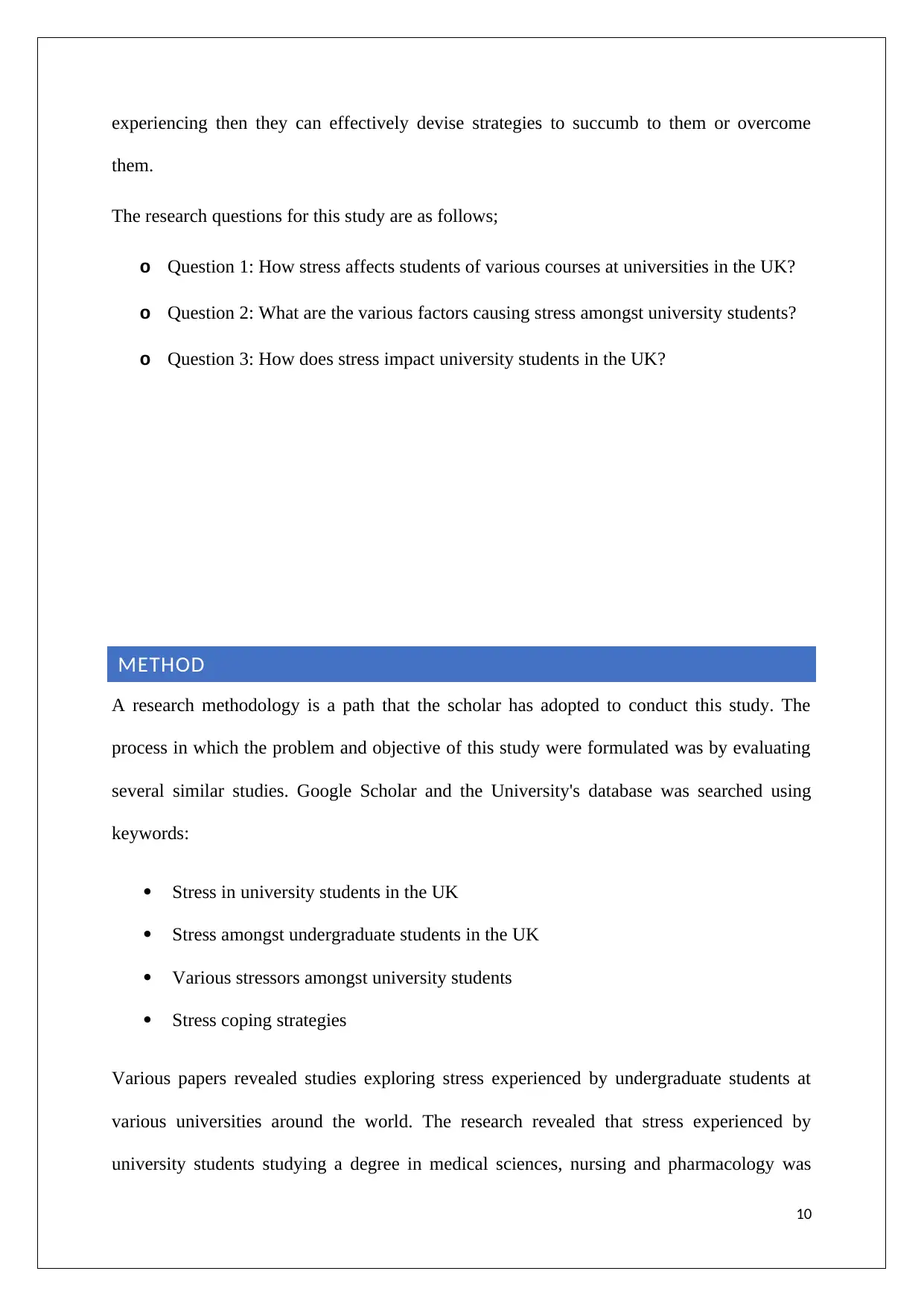
experiencing then they can effectively devise strategies to succumb to them or overcome
them.
The research questions for this study are as follows;
o Question 1: How stress affects students of various courses at universities in the UK?
o Question 2: What are the various factors causing stress amongst university students?
o Question 3: How does stress impact university students in the UK?
METHOD
A research methodology is a path that the scholar has adopted to conduct this study. The
process in which the problem and objective of this study were formulated was by evaluating
several similar studies. Google Scholar and the University's database was searched using
keywords:
Stress in university students in the UK
Stress amongst undergraduate students in the UK
Various stressors amongst university students
Stress coping strategies
Various papers revealed studies exploring stress experienced by undergraduate students at
various universities around the world. The research revealed that stress experienced by
university students studying a degree in medical sciences, nursing and pharmacology was
10
them.
The research questions for this study are as follows;
o Question 1: How stress affects students of various courses at universities in the UK?
o Question 2: What are the various factors causing stress amongst university students?
o Question 3: How does stress impact university students in the UK?
METHOD
A research methodology is a path that the scholar has adopted to conduct this study. The
process in which the problem and objective of this study were formulated was by evaluating
several similar studies. Google Scholar and the University's database was searched using
keywords:
Stress in university students in the UK
Stress amongst undergraduate students in the UK
Various stressors amongst university students
Stress coping strategies
Various papers revealed studies exploring stress experienced by undergraduate students at
various universities around the world. The research revealed that stress experienced by
university students studying a degree in medical sciences, nursing and pharmacology was
10
Paraphrase This Document
Need a fresh take? Get an instant paraphrase of this document with our AI Paraphraser
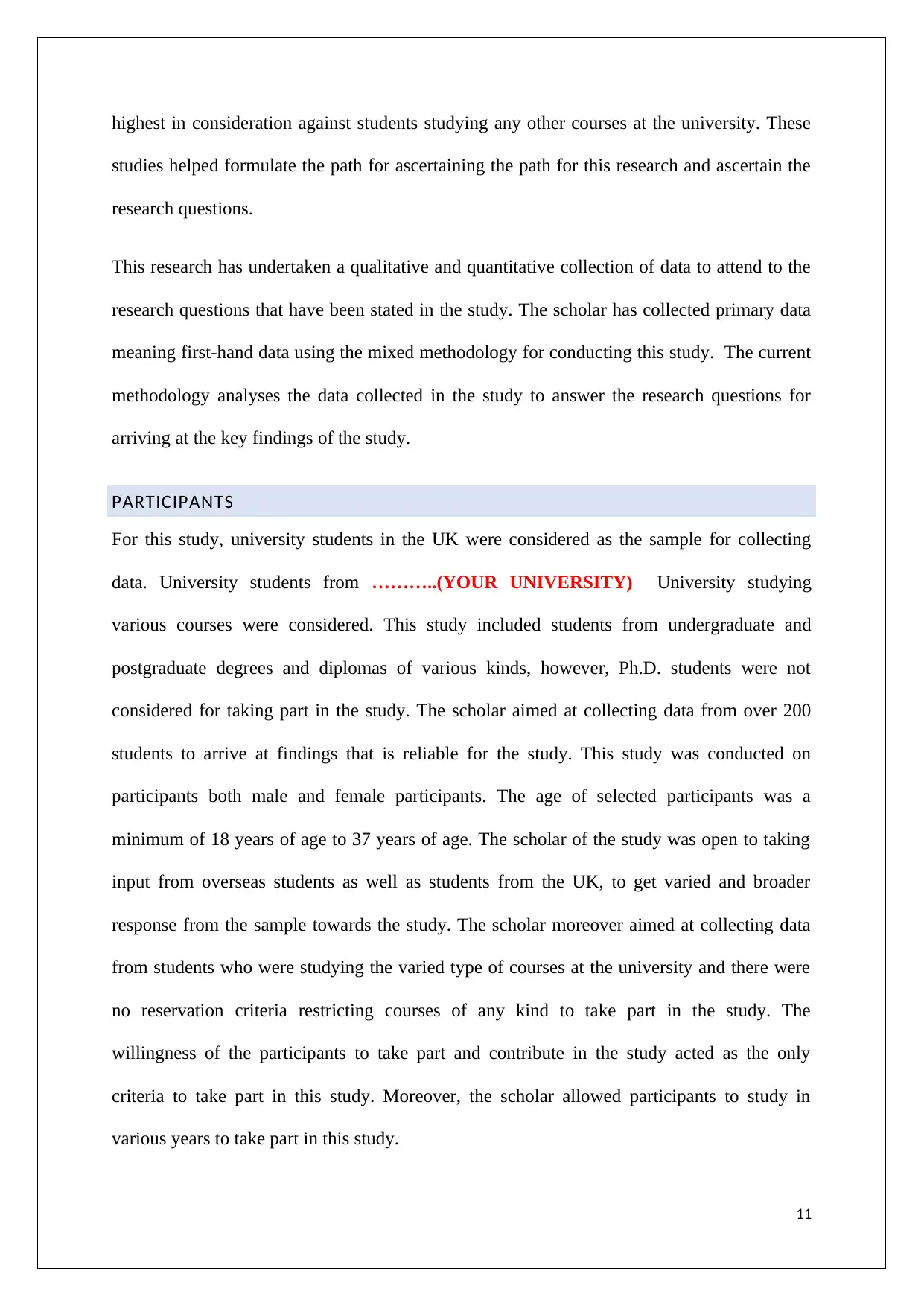
highest in consideration against students studying any other courses at the university. These
studies helped formulate the path for ascertaining the path for this research and ascertain the
research questions.
This research has undertaken a qualitative and quantitative collection of data to attend to the
research questions that have been stated in the study. The scholar has collected primary data
meaning first-hand data using the mixed methodology for conducting this study. The current
methodology analyses the data collected in the study to answer the research questions for
arriving at the key findings of the study.
PARTICIPANTS
For this study, university students in the UK were considered as the sample for collecting
data. University students from ………..(YOUR UNIVERSITY) University studying
various courses were considered. This study included students from undergraduate and
postgraduate degrees and diplomas of various kinds, however, Ph.D. students were not
considered for taking part in the study. The scholar aimed at collecting data from over 200
students to arrive at findings that is reliable for the study. This study was conducted on
participants both male and female participants. The age of selected participants was a
minimum of 18 years of age to 37 years of age. The scholar of the study was open to taking
input from overseas students as well as students from the UK, to get varied and broader
response from the sample towards the study. The scholar moreover aimed at collecting data
from students who were studying the varied type of courses at the university and there were
no reservation criteria restricting courses of any kind to take part in the study. The
willingness of the participants to take part and contribute in the study acted as the only
criteria to take part in this study. Moreover, the scholar allowed participants to study in
various years to take part in this study.
11
studies helped formulate the path for ascertaining the path for this research and ascertain the
research questions.
This research has undertaken a qualitative and quantitative collection of data to attend to the
research questions that have been stated in the study. The scholar has collected primary data
meaning first-hand data using the mixed methodology for conducting this study. The current
methodology analyses the data collected in the study to answer the research questions for
arriving at the key findings of the study.
PARTICIPANTS
For this study, university students in the UK were considered as the sample for collecting
data. University students from ………..(YOUR UNIVERSITY) University studying
various courses were considered. This study included students from undergraduate and
postgraduate degrees and diplomas of various kinds, however, Ph.D. students were not
considered for taking part in the study. The scholar aimed at collecting data from over 200
students to arrive at findings that is reliable for the study. This study was conducted on
participants both male and female participants. The age of selected participants was a
minimum of 18 years of age to 37 years of age. The scholar of the study was open to taking
input from overseas students as well as students from the UK, to get varied and broader
response from the sample towards the study. The scholar moreover aimed at collecting data
from students who were studying the varied type of courses at the university and there were
no reservation criteria restricting courses of any kind to take part in the study. The
willingness of the participants to take part and contribute in the study acted as the only
criteria to take part in this study. Moreover, the scholar allowed participants to study in
various years to take part in this study.
11
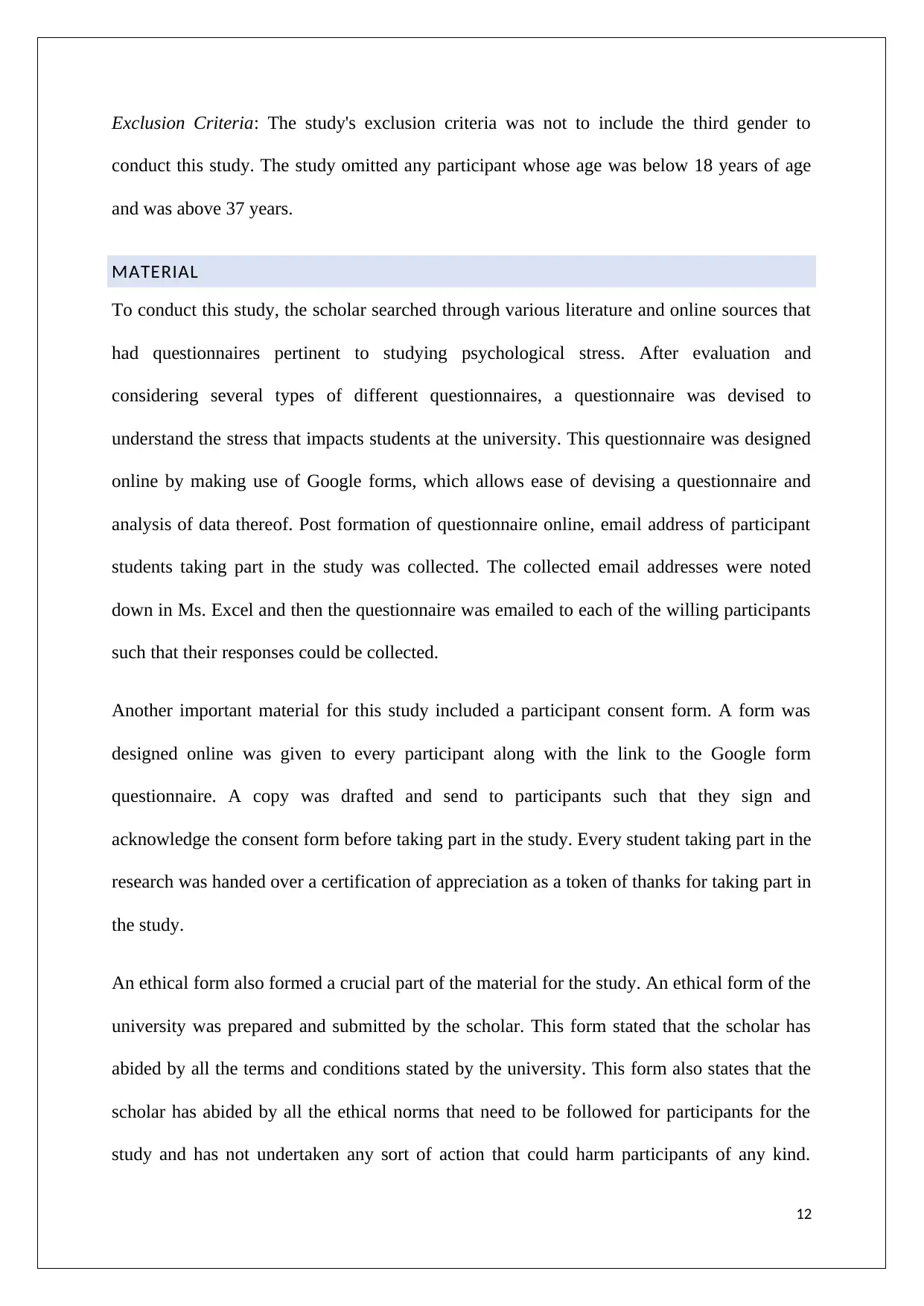
Exclusion Criteria: The study's exclusion criteria was not to include the third gender to
conduct this study. The study omitted any participant whose age was below 18 years of age
and was above 37 years.
MATERIAL
To conduct this study, the scholar searched through various literature and online sources that
had questionnaires pertinent to studying psychological stress. After evaluation and
considering several types of different questionnaires, a questionnaire was devised to
understand the stress that impacts students at the university. This questionnaire was designed
online by making use of Google forms, which allows ease of devising a questionnaire and
analysis of data thereof. Post formation of questionnaire online, email address of participant
students taking part in the study was collected. The collected email addresses were noted
down in Ms. Excel and then the questionnaire was emailed to each of the willing participants
such that their responses could be collected.
Another important material for this study included a participant consent form. A form was
designed online was given to every participant along with the link to the Google form
questionnaire. A copy was drafted and send to participants such that they sign and
acknowledge the consent form before taking part in the study. Every student taking part in the
research was handed over a certification of appreciation as a token of thanks for taking part in
the study.
An ethical form also formed a crucial part of the material for the study. An ethical form of the
university was prepared and submitted by the scholar. This form stated that the scholar has
abided by all the terms and conditions stated by the university. This form also states that the
scholar has abided by all the ethical norms that need to be followed for participants for the
study and has not undertaken any sort of action that could harm participants of any kind.
12
conduct this study. The study omitted any participant whose age was below 18 years of age
and was above 37 years.
MATERIAL
To conduct this study, the scholar searched through various literature and online sources that
had questionnaires pertinent to studying psychological stress. After evaluation and
considering several types of different questionnaires, a questionnaire was devised to
understand the stress that impacts students at the university. This questionnaire was designed
online by making use of Google forms, which allows ease of devising a questionnaire and
analysis of data thereof. Post formation of questionnaire online, email address of participant
students taking part in the study was collected. The collected email addresses were noted
down in Ms. Excel and then the questionnaire was emailed to each of the willing participants
such that their responses could be collected.
Another important material for this study included a participant consent form. A form was
designed online was given to every participant along with the link to the Google form
questionnaire. A copy was drafted and send to participants such that they sign and
acknowledge the consent form before taking part in the study. Every student taking part in the
research was handed over a certification of appreciation as a token of thanks for taking part in
the study.
An ethical form also formed a crucial part of the material for the study. An ethical form of the
university was prepared and submitted by the scholar. This form stated that the scholar has
abided by all the terms and conditions stated by the university. This form also states that the
scholar has abided by all the ethical norms that need to be followed for participants for the
study and has not undertaken any sort of action that could harm participants of any kind.
12
⊘ This is a preview!⊘
Do you want full access?
Subscribe today to unlock all pages.

Trusted by 1+ million students worldwide
1 out of 41
Related Documents
Your All-in-One AI-Powered Toolkit for Academic Success.
+13062052269
info@desklib.com
Available 24*7 on WhatsApp / Email
![[object Object]](/_next/static/media/star-bottom.7253800d.svg)
Unlock your academic potential
Copyright © 2020–2025 A2Z Services. All Rights Reserved. Developed and managed by ZUCOL.





